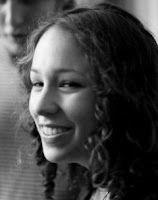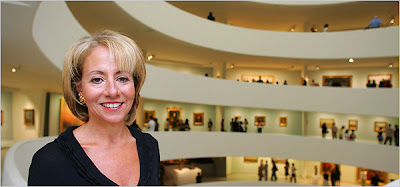“XXX”… the first-ever Alumni Reunion Exhibition
Friday, November 5th, 6-8 pm
The exhibition will remain on view through November 20. This exhibition is free and open to the public 2 – 8 pm or by appointment. Closed Tuesdays and Holidays. For more information, please email Charis at ccarmichaelbraun@nyaa.edu.
Click for more information about recent Exhibitions and Alumni at the Academy.
Hilary Harkness: Notes from Studio Lockdown
The New York Academy of Art is pleased to introduce a new and ongoing bi-monthly series on this blog. Artist Hilary Harkness will be regularly posting “Notes from Studio Lockdown” as she prepares for her upcoming exhibition at Mary Boone Gallery in New York City. See below for her first “Note” and follow her on this blog as she pulls it all together!
 |
| detail from Iowa Class |
I am going into exile to prepare for my show on May 5th, 2011 at Mary Boone Gallery, NYC. I have two paintings to complete, and time is running short! My posts on the Academy’s blog will exist within the confines of this academic year only (2010-2011). Included in this series will be the following:
- photo documentation from start to finish of each painting
- technical information
- links to videos interviews by an “innocent eye” – someone without an arts background – who asks me questions I might not think to answer otherwise
- a tell-all account about painting on deadline – is survival possible?
- time management tips for artists, or conversely, how to make painting as difficult as possible!
NYAA students, as you battle with your coursework and deadlines, you are not alone.
I am with you in a parallel universe, coping with many of the same issues and willing to lend an ear. Because most professional artists guard their “secrets” and protect their privacy, I offer this documentation as something I had personally wished for while in school: a candid look over the shoulder of a practicing professional artist.
Yours very truly,
Hilary Harkness
Art & Culture Lecture: Ken Currie
.jpg) |
| The first light of day (triptych), oil on canvas |
is a Scottish painter, born in North Shields, England. He is one of the most influential living artists in Scotland. His paintings are displayed in public and museum collections worldwide. Currie’s paintings are concerned with how the human body is affected by illness, aging and physical injury, social and political issues or philosophical questions.
Next up: Pablo Helguera, Tuesday, November 9, 7:30pm
- Related titles on Scottish art in history and contemporary Scottish painting.
- Access to articles and reviews through our electronic database subscriptionsl.
- Images in ArtStor, collected in the Ken Currie image group for easy retrieval.
The Players Club
A lot of heavy hitters this week so I’ll keep it short and sweet.
 |
| Currin |
Gagosian has a major Rauschenberg show and Anselm Keifer in Chelsea and a John Currin show uptown. The Rauschenberg show consists of a survey of his work from his early ‘Combines’ to the silk screen paintings of the 1960’s. The Currin show consists of new paintings in his typical idealized, perverse fashion. Also uptown a show of Jenny Holzer‘s early work is at Skarstedt Gallery. The show consists of Holzer’s signs spanning a decade from the late 1970’s to the late 1980’s.
 |
| Kent Dorn |
In Chelsea Kent Dorn Remains is at Freight and Volume. Dorn’s multi media, dreamy landscape paintings celebrate disenchanted suburban youth and their search for nature.
If you like Kent Dorn’s work then you can also go see his counterpart Kim Dorland’s New Material at Mike Weiss.
 |
| Dorland |
 |
| Pettibon |
Also in Chelsea Luc Tuymans Corporate and Raymond Pettibon Hard in the Paint are open at the two David Zwirner locations. In this show Tuymans turns his attention to modern day corporate culture. Pettibon’s work on the other hand embraces a wide spectrum of American ‘high’ and ‘low’ culture.
 |
| Mutu |
If you haven’t gone yet, don’t miss Wangechi Mutu’s incredible painted collages in Hunt Bury Flee at Barbara Gladstone in Chelsea.
Fellows: John, Maya and Austin
This post begins a new series on the Academy’s blog about the unique opportunity offered through the Postgraduate Fellowship at the New York Academy of Art.
Each year, the Academy selects three outstanding graduating students to serve as postgraduate fellows. During their fellowship year, these artists are able to take advantage of studio accommodations at the Academy, exhibition offerings, tutorial support and opportunities for teaching assistantships. At the beginning of the school year following their appointment (September), the Academy holds an exhibition dedicated to the work the fellows have done during their residency.
Fellows often find this opportunity instrumental in the definition of their artistic voices. The 2010-2011 Fellows John O’Reilly, Maya Brodsky and Austin Park will be exploring this exciting time in their careers with a series of brief Q & A posts over their residency. Follow the fellows on this blog and see their progress!
John: During my fellowship, I hope to create more complex schematics and expand on my initial artist’s statement by combing traditional modeling techniques with the exploration of contemporary ideas focusing on the commonalities between the human figure and animal species. I hope to collaborate and aid emerging artist by relaying my experiences to incoming students. I wish use this opportunity to start my professional career, paying tribute to the Academy by serving as an example of a successful rising artist in the contemporary world of art.

Maya: I hope to learn how to effectively express what is important to me. To accomplish this, my strategy is to spend as much time as possible working in the studio, reading, writing, and looking at lots of art. I often spend too much time theorizing and trying to figure out what I need to do, how to do it, and what isn’t good enough in my past work. I hope to pause this practice in order to paint and see what happens.
Austin: On the surface, the fellowship allows me to continue the momentum of a series of work that began the summer between first and second year at the academy. But most importantly, this opportunity keeps me immersed in an environment of feedback and dialogue about the type of art that excites and inspires me. It is an experience beyond just creating art as there is still so much more to absorb and learn in all aspects of being a professional artist during this time. There is potential for certain things I’ve discovered in my work but I’m looking forward to exploring some ideas that I haven’t yet developed and experimenting more with materials. I plan on continuing to make work that uses the figure and environment at odds with each other and emphasize an infatuation with generic cinematic body language. I would like to also continue more printmaking, specifically reductive and multi-block woodcuts that were started near the end of last year.
Art & Culture Lecture: Lisa Dennison
Lisa Dennison, Chair of Sotheby’s North and South America, interned at the Guggenheim Museum while in college, and returned in 1978 after completing graduate studies in art history. Working her way up over a 29 year career at the museum, she oversaw many important exhibitions, advised multi-billionaire collectors, developed a reputation as a leading fund-raiser, and became an expert in Contemporary Art. In 2005 she was named director of the Guggenheim Museum, a position she held for two years before moving to the for-profit world to work for Sotheby’s Auction House.
 |
| Click to read about Ms. Dennison in The New York Times. |
All lectures are free and open to the public, bring a friend!Next up: Ken Currie, Tuesday, November 2, 7:30pm
Hot Air Balloon
by Emily D. Adams (MFA 2011)
Paradise
is the Persian word for Garden. Its literal translation is a ‘walled enclosure,’ and has been handed down from sometime around 4000 BCE through the Egyptians and the Moors, to the Spanish medieval cloister and the Italian Renaissance, changing in styles and scope like the English Gardenesque, the botanical, and the mighty National Park. With all its otherworldly connotations, it’s interesting to me that the origin of the word, paradise, and the history of the garden, imply a human hand in the creation of these spaces.

 |
| study, oil on paper |
 |
| study, oil on paper |
In preparation for my thesis, I am developing work that explores the theme of the garden through different configurations of aerial landscape photos and floral still-life. I’ve also been painting from film stills of singing women — a seemingly disconnected endeavor that will hopefully evolve in tandem.

In Vincent Desiderio’s painting seminar, we will be watching films by the great Soviet filmmaker, Andrei Tarkovsky. In the opening to his Passion According to Andre Rublev, a young man escapes from the roof of a church in a hot air balloon. As viewers, we are shown the aerial perspective of 15th century Russian landscape. It is a view, unthinkable for the time the film portrays, that returns throughout the movie as a metaphor, perhaps, for the perspective the artist is able to reach through his wild creative faith. But his faulty technological innovation, the hot air balloon, brings him crashing down after a brief moment of escape from the earthen world.
Lightning Rod: Hilary Harkness
Hilary Harkness is a painter represented by Mary Boone Gallery in NYC. She draws inspiration from multi-disciplinary sources – history (including WWII), literature (such as the work of Ernest Hemingway and Gertrude Stein), and women’s studies (focused on issues of inclusion and historical representation). One strategy she has employed to interrogate the historical narrative has been re-casting WWII events with all-female characters, allowing her to explore universals (e.g., power struggles, chains of command, the sheer exertion of will and desire) without the distraction of gender-biases. Her upcoming show at Mary Boone Gallery opens May 5th, 2011.
Art & Culture Lecture: Ross Bleckner
 |
| The Sun Into Ourselves, 72″ x 96″ Oil on Paper mounted on Alumninum, 2009 |
Artist Ross Bleckner was born in New York City. He received an MFA from Cal Arts in 1973 and has taught at many of the nation’s most prestigious universities. The Guggenheim had a major retrospective of his works in 1995, summarizing two decades of solo shows at internationally acclaimed exhibition venues such as SFMoMA, Contemporary Arts Museum, Stockholm Moderna Museet, and the Carnegie Museum of Art. Works by Mr. Bleckner are also held in esteemed public collections throughout the globe, including MoMA, MoCA, Astrup Fearnley, Museo National Centro de Arte Reina Sofia, and the Whitney Museum of American Art. Not only has Mr. Bleckner had a profound impact of shaping the New York art world, his philanthropic efforts have enabled many community organizations to perform their vital work.
“His art has been largely an investigation of change, loss, and memory, often addressing the subject of AIDS. But Mr. Bleckner uses symbolic imagery rather than direct representation, and his work is visually elusive, with forms that constantly change focus.â€
– Harrison, Helen A. “An Artist’s Investigation of Loss and Memory” The New York Times, January 2, 2005.
All lectures are free and open to the public, bring a friend!
Next up:Â Lisa Dennison, Tuesday, October 26, 7:30pm
Action, and Traction
by Aliene de Souza Howell (MFA 2011)
 |
| Self-portrait, Till Fog and Clear of Midnight |


| New Diorama with Desiderio suggestions! |

And I can’t wait to hear what Odd Nerdrum has to say this week!




